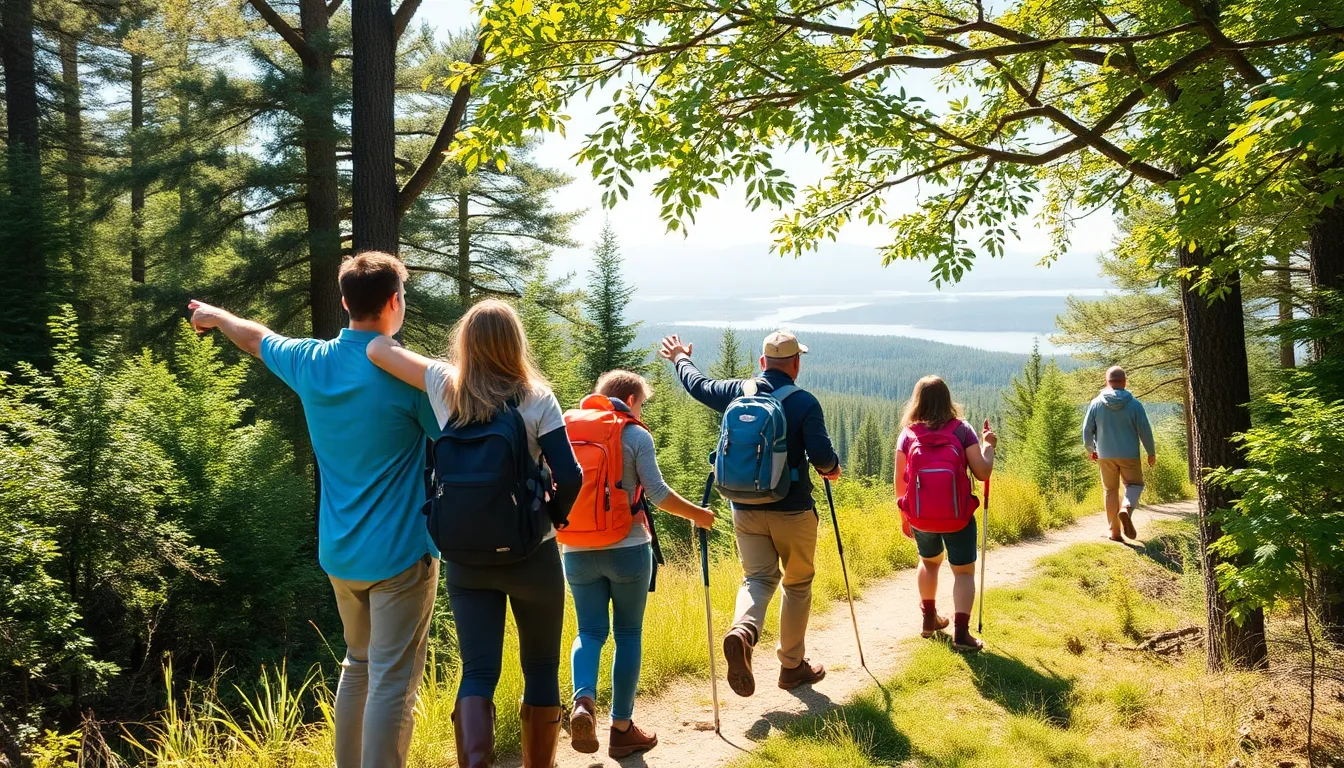Nothing beats the great outdoors when it comes to making unforgettable family memories. Whether it’s a sunny day at the park or a spontaneous camping trip, outdoor family activities can turn an ordinary weekend into an extraordinary adventure. Imagine the laughter echoing through the trees as everyone races to the top of a hill or the joy of roasting marshmallows under a starlit sky. It’s not just fun; it’s bonding time that builds stronger connections.
Table of Contents
ToggleBenefits of Outdoor Family Activities
Engaging in outdoor family activities offers numerous benefits, ranging from improved physical health to enhanced mental well-being.
Physical Health
Outdoor family activities promote better physical health through increased exercise. Parents and children alike benefit from engaging in various activities such as hiking, biking, or playing sports. Regular physical activity helps maintain a healthy weight, reduces the risk of chronic diseases, and strengthens muscles and bones. For example, a family hiking on a trail may burn over 400 calories per hour, making it an effective way to stay active together. Activities that involve movement not only improve cardiovascular health but also enhance coordination and balance, laying the foundation for a physically fit lifestyle.
Mental Well-being
Engaging in outdoor family activities significantly boosts mental well-being. Nature exposure reduces stress, anxiety, and symptoms of depression. Families can enjoy the calming effects of fresh air and natural environments, which encourage relaxation and mindfulness. For instance, spending time in a park or a forest can increase feelings of happiness and connection. Group activities foster communication and collaboration, improving interpersonal relationships within the family. By creating shared experiences, families enhance their emotional bonds, leading to greater overall life satisfaction.
Popular Outdoor Family Activities

Outdoor family activities foster connection and create cherished memories. Engaging in these adventures promotes both physical health and emotional well-being.
Hiking Adventures
Hiking adventures offer families a chance to explore nature together. Families can choose trails based on skill levels to accommodate everyone. Many trails provide scenic views, wildlife sightings, and opportunities for learning about the environment. For example, a family hiking for two hours can burn approximately 600 calories, increasing their physical activity significantly. Packing snacks and water ensures everyone stays energized and hydrated during the trek.
Camping Trips
Camping trips allow families to bond while experiencing the great outdoors. Families can set up tents in national parks or campsites, creating a home away from home. Activities like fishing, swimming, and storytelling around a campfire enhance the experience. Many campsites provide amenities like fire pits and picnic tables, making meal preparation simple. Enjoying the nights under the stars fosters connections and promotes relaxation while escaping daily routines.
Outdoor Sports
Outdoor sports facilitate friendly competition and teamwork. Families can engage in activities like soccer, basketball, or frisbee in local parks or backyards. These games encourage physical fitness and help improve coordination and agility. Joining local leagues or classes also cultivates social connections with other families. Families participating in sports can build skills while enjoying quality time together.
Nature Walks
Nature walks focus on appreciating the environment at a leisurely pace. Families can explore local parks, botanical gardens, or nature reserves, observing plants and wildlife. Guided nature walks often include educational components, especially about local ecosystems. Families can engage children by encouraging them to identify various plants and animals encountered along the way. These walks provide an excellent opportunity for conversation and discovery, enriching family relationships.
Planning Your Outdoor Family Activities
Planning outdoor family activities requires thoughtful consideration to ensure everyone enjoys the experience. Factors like location and essential gear come into play for a memorable outing.
Choosing a Suitable Location
Choosing a suitable location involves assessing family interests and physical abilities. Families can explore national parks, local trails, or community playgrounds, each offering unique benefits. National parks provide diverse landscapes and wildlife, enhancing adventure. Local trails cater to beginners, ensuring safety and accessibility. Community playgrounds encourage active play and social interaction. Weather conditions also factor into this decision, where sunny days are ideal for hiking or picnicking. Aim for locations that foster engagement and connection among family members for a rewarding experience.
Packing Essentials
Packing essentials ensures a smooth outing for families. Prioritize items like water, snacks, sun protection, and first aid kits. Bring enough water to stay hydrated, with at least one liter per person per hour during activities. Healthy snacks, such as fruit or granola bars, provide energy throughout the day. Include sunscreen and hats for adequate sun protection, especially during peak hours. First aid kits should contain band-aids, antiseptic wipes, and pain relievers for safety. Additionally, consider packing games or outdoor toys to enhance entertainment. Preparing these essentials ensures comfort and allows families to focus on creating enjoyable memories.
Safety Tips for Outdoor Family Activities
Safety remains a priority during outdoor family activities. Considerations around weather and first aid preparedness ensure a safe and enjoyable experience.
Weather Considerations
Weather conditions can change rapidly, impacting outdoor activities. Check forecasts before heading out, looking for temperature, precipitation, and wind advisories. Dress in layers to accommodate temperature fluctuations, ensuring comfort throughout the day. Pack rain gear and sun protection, like hats and sunscreen, to prevent sunburn or hypothermia. Schedule activities for cooler parts of the day during hot months to avoid heat-related illnesses. Communicate with the family about potential weather changes and adjust plans accordingly. For instance, if thunderstorms are predicted, consider indoor alternatives.
First Aid Preparedness
First aid preparedness is essential for outdoor family activities. Pack a comprehensive first aid kit, including adhesive bandages, antiseptic wipes, pain relievers, and insect bite remedies. Ensure all family members know the kit’s location and contents. Take a Basic First Aid course to equip family members with essential skills for managing minor injuries. Carry any personal medications and use waterproof containers to protect them from the elements. Communicate potential hazards, such as slippery surfaces or wildlife encounters, helping everyone remain vigilant. Regularly evaluate family members for signs of fatigue or discomfort to address concerns promptly.
Embracing outdoor family activities can truly transform everyday life into a collection of unforgettable moments. By engaging in these adventures, families not only foster deeper connections but also promote healthier lifestyles.
The benefits extend beyond just physical health; they enhance mental well-being and create a sense of unity among family members. With careful planning and a focus on safety, families can explore the great outdoors, making memories that last a lifetime.
Whether it’s hiking through scenic trails or enjoying a cozy camping trip, the opportunities for fun and bonding are endless. Taking the time to step outside together can lead to a happier and more fulfilled family life.






